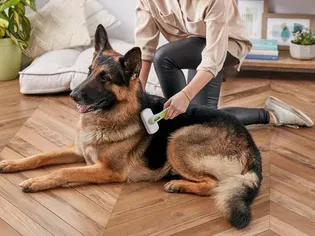Dealing With a Shedding Dog
Updated on 05/27/24

Unlocking the Secrets of Dealing with a Shedding Dog: A Comprehensive Guide
As a cherished companion to many households, dogs bring an abundance of joy, companionship, and unconditional love. However, shedding can be an inevitable and often frustrating reality for dog owners. Excessive hair accumulation can not only be a nuisance but also a potential health hazard if not managed effectively. This comprehensive guide delves into the world of dog shedding, providing practical solutions and essential tips to help you tackle this furry challenge.
Understanding the Nature of Dog Shedding
Shedding, the natural process of losing old hair to make way for new, is a common occurrence in both short-haired and long-haired dogs. Factors such as breed, age, health, and climate play a significant role in determining the extent of shedding. Certain breeds, like Huskies and German Shepherds, are notorious for their heavy shedding, while Poodles and Bichons Frise are considered hypoallergenic breeds with minimal shedding.
Common Causes of Excessive Shedding
While shedding is a natural phenomenon, there are instances where excessive hair loss can indicate underlying health issues. Some of the most common causes include:
* Allergies: Environmental allergens, such as pollen or dust mites, can trigger allergic reactions that lead to excessive scratching and hair loss.
* Parasites: Flea or tick infestations can cause intense itching and irritation, resulting in hair loss.
* Skin infections: Bacterial or fungal skin infections can damage hair follicles and cause hair loss.
* Hormonal imbalances: Thyroid issues, Cushing's disease, and pregnancy can disrupt hormone levels, leading to hair loss.
* Stress: Chronic stress can trigger hair loss in dogs.
Effective Shedding Management
Managing shedding effectively requires a multi-pronged approach that addresses both preventive and remedial measures. Here are some practical tips:
* Regular Brushing: Brushing your dog's coat at least twice a week removes loose hairs, stimulates hair follicles, and distributes natural oils, promoting healthy hair growth. Choose a brush that is appropriate for your dog's coat type.
* Bathing: Regular bathing with a gentle dog shampoo helps remove excess hair and dirt, reducing shedding. Avoid over-bathing, as this can strip the coat of its natural oils, leading to dryness and irritation.
* Dietary Supplementation: A balanced diet rich in essential nutrients, such as omega-3 fatty acids, can support healthy skin and coat and reduce shedding. Consult with your veterinarian to determine the appropriate supplements for your dog.
* Vacuum Regularly: Vacuuming frequently helps remove loose hair from carpets, furniture, and other surfaces, minimizing the spread of allergens and reducing the appearance of shedding.
* Grooming: Professional grooming sessions, which include bathing, brushing, and trimming, can effectively remove dead hair and promote healthy coat growth.
Health Considerations
Excessive shedding can sometimes be a sign of an underlying health issue. If you notice any unusual hair loss or other symptoms, such as lethargy, itching, or skin irritation, it's crucial to consult with your veterinarian to rule out any medical conditions that may require treatment.
Home Remedies for Shedding
In addition to the aforementioned strategies, some home remedies can provide temporary relief from excessive shedding:
* Apple Cider Vinegar Rinse: Diluted apple cider vinegar added to your dog's bathwater can balance pH levels, reduce itching, and promote a healthy coat.
* Coconut Oil: Massaging coconut oil into your dog's coat can moisturize the skin and hair, reducing dryness and shedding.
* Oatmeal Bath: Oatmeal has soothing and anti-inflammatory properties that can help relieve skin irritation and reduce shedding.
Conclusion
Dealing with a shedding dog requires a holistic approach that combines preventive measures, grooming practices, and addressing underlying health issues. By following the tips outlined in this guide, you can effectively control shedding, maintain a healthy coat, and ensure the well-being of your furry companion. Remember, consistency and patience are key to achieving long-term results. Consult with your veterinarian for personalized recommendations tailored to your dog's specific needs.
Explore More Pets

Basic Training
Puppy and Baby Introductions

Working Dog Breeds
All About Search and Rescue Dogs

Dog Treatments
Puppy Vaginitis: Signs, Causes and Treatment

Dog Adoption
After More Than 1,200 Days in the Shelter, Coco Goes Home

Basic Training
How to Train Your Puppy to Go on Potty Pads

Hybrid Dog Breeds
The Difference Between a Mutt, Mixed Breed, or Designer Dog?

Dog Treatments
Nail Problems in Dogs

Puppies
7 Reasons Why Two Dogs Are Better Than One
